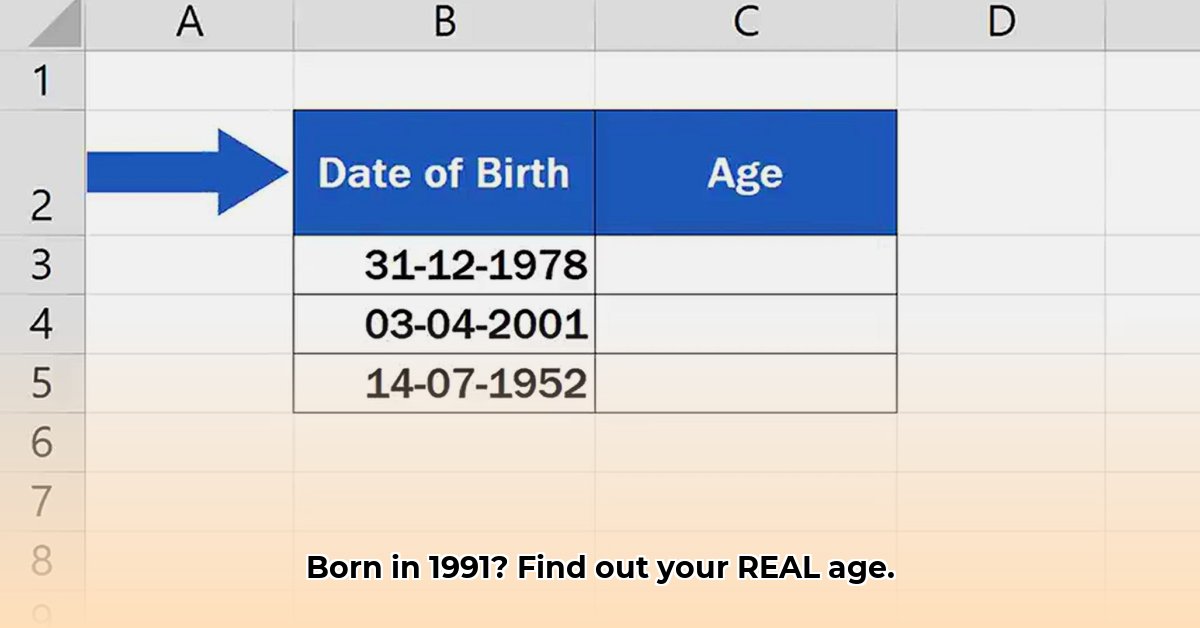
If you were born in 1991, how old are you?
Determining someone's age seems trivial; simply subtract their birth year from the current year. However, this seemingly straightforward calculation reveals surprising complexities, particularly when considering diverse cultural practices. Therefore, if you were born in 1991, are you truly 34 years old in 2025? The answer, as we will demonstrate, is nuanced. For another example, see how to calculate age for someone born in 1963 here.
Beyond Simple Subtraction: The Global Landscape of Age Calculation
In Western societies, age calculation is typically straightforward: subtracting the birth year from the current year. However, numerous cultures employ alternative systems. For example, traditional Chinese age calculation begins at one at birth, with an annual increment occurring at the Lunar New Year. This implies that an individual's age may vary depending on the system used, highlighting the importance of accurate and culturally-sensitive age determination. This isn't merely an academic curiosity; it has significant real-world implications. International businesses, researchers, and healthcare providers frequently encounter this issue, with inconsistencies potentially leading to flawed data and substantial consequences.
Birthdate Precision: A Key Factor in Age Calculation
Returning to the initial question: if born in 1991, your precise age in 2025 depends on your birthdate. Someone born on January 1st, 1991, will be a different age than someone born on December 31st, 1991, on the same date in 2025. These seemingly minor differences, however, accumulate significantly.
Illustrative Examples:
- Born January 1st, 1991: This individual would be 34 years old on March 10th, 2025.
- Born December 31st, 1991: This individual would still be 33 years old on March 10th, 2025.
This underscores that the birth year alone lacks sufficient precision for accurate age determination. Complete birthdate information—day, month, and year—is essential.
A Practical Guide to Cross-Cultural Age Calculation
Accurate age determination necessitates understanding cultural contexts. Here's a step-by-step guide:
- Identify the Age System: Determine whether the standard Western method or a culturally specific system is employed.
- Obtain the Full Birthdate: Acquire the precise day, month, and year of birth.
- Specify the Calculation Date: Clearly define the date for which the age is being calculated.
- Utilize Appropriate Tools: Employ online calculators or software designed to handle cultural variations in age calculation. 1
- Contextualize the Results: Always consider the individual's cultural background when interpreting age-related data.
The Significance of Accurate Age Data: Real-World Applications
Precise age determination isn't just about numerical accuracy; it has profound implications across various sectors:
- Healthcare: Accurate age is crucial for appropriate treatment, research design, and effective clinical decision-making. "Precise age data is fundamentally important to personalized medicine" says Dr. Anya Sharma, Epidemiologist at the World Health Organization.
- Government Programs: Eligibility for social security, Medicare, and other government benefits is often age-dependent.
- Legal Frameworks: Laws regarding voting, driving, and other activities are often age-based, demanding precise age verification.
- Marketing and Advertising: Age-based targeting is a cornerstone of effective marketing strategies.
Inaccurate age data undermines the reliability of these critical systems, potentially leading to flawed analyses, policy errors, and legal challenges.
Navigating the Challenges and Future Directions of Age Calculation
Currently, a global standard for age calculation remains elusive. This lack of standardization presents significant challenges. Experts are actively developing improved, inclusive methods that account for cultural diversity. This effort, while challenging, is essential for ensuring the fairness and accuracy of data across diverse populations.
Mitigating Risks Associated with Age Data
| Risk Category | Likelihood | Impact | Mitigation Strategies |
|---|---|---|---|
| Misinterpretation of Age System | High | High | Thoroughly explain all calculation methods and their cultural contexts. |
| Inaccurate Data Entry | Moderate | Moderate | Implement stringent data validation procedures and quality checks. |
| Cultural Insensitivity | Low | Moderate | Prioritize cultural awareness training and sensitive data handling. |
| Legal and Regulatory Non-Compliance | Low | High | Seek expert legal counsel to ensure compliance with all relevant laws. |
In conclusion, if you were born in 1991, your age isn't simply 34. It's contingent upon the chosen age calculation system and the precision of the birthdate used. Understanding the subtleties of age calculation is vital for accuracy, fairness, and responsible data management across diverse cultural contexts.